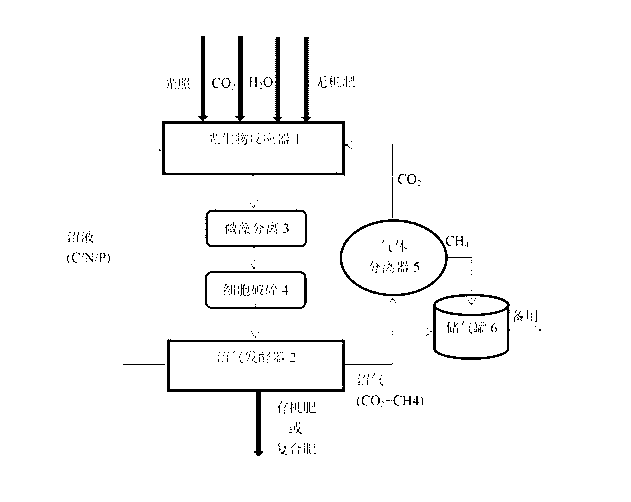Method for producing biogas energy while preparing organic fertilizer or compound fertilizer by using inorganic fertilizer
A technology of inorganic fertilizer and organic fertilizer, applied in the fields of agriculture and energy, can solve the problems of uncollected and utilized biogas, lack of quick-acting fertility, complicated procedures, etc., so as to increase the preservation of soil moisture, improve soil structure, and improve soil structure.
- Summary
- Abstract
- Description
- Claims
- Application Information
AI Technical Summary
Problems solved by technology
Method used
Image
Examples
Embodiment 1
[0041] A method for producing organic fertilizer or compound fertilizer from inorganic fertilizer and simultaneously producing biogas energy, the method comprises the following steps: (1) putting 1000m 3 water, take 1m 3 The greenish river water is inoculated with microalgae and poured into the photobioreactor. (2) Take inorganic fertilizer and add it into the bioreactor. After dissolution, the nitrogen and phosphorus concentrations are 1mg / L and 0.2mg / L respectively. Under the natural sunlight, the biomass of microalgae grows steadily. (3) When the biomass reaches 5g / L, the microalgae are separated by filtration, and put into a biogas fermenter after ultrasonic crushing. (4) The microalgae stays in the biogas fermenter for 10 days, 40% of which are converted into biogas, 30% into biogas slurry, and 30% into biogas residue. The biogas enters the gas storage tank for standby, the biogas slurry flows back to the photobioreactor, and the biogas residue is used as compound ferti...
Embodiment 2
[0043] A method for producing organic fertilizer or compound fertilizer from inorganic fertilizer and simultaneously producing biogas energy, the method comprises the following steps: (1) putting 1m in the photobioreactor 3 Water, take 1L of green river water to inoculate microalgae, and pour it into the photobioreactor. (2) Take inorganic fertilizer and add it into the bioreactor. After dissolution, the nitrogen and phosphorus concentrations are 0.1mg / L and 0.02mg / L respectively. Under the natural sunlight, the biomass of microalgae grows steadily. (3) When the biomass reaches 0.5g / L, the microalgae are separated by filtration, and put into the biogas fermenter after ultrasonic crushing. (4) The microalgae stays in the biogas fermenter for 3 days, 40% of which are converted into biogas, 40% into biogas slurry, and 20% into biogas residue. The biogas enters the gas storage tank for standby, the biogas slurry flows back to the photobioreactor, and the biogas residue is used as...
Embodiment 3
[0045] A method for producing organic fertilizer or compound fertilizer from inorganic fertilizer and simultaneously producing biogas energy, the method comprises the following steps: (1) putting 5m in the photobioreactor 3 Water, buy Chlorella (Chlorella), and inoculate into the photobioreactor after expansion. (2) Take inorganic fertilizer and add it into the bioreactor. After dissolution, the concentration of nitrogen and phosphorus are 10mg / L and 2mg / L respectively. Under the natural sunlight, the biomass of microalgae grows steadily. (3) When the biomass reaches 50g / L, the microalgae are separated by filtration, and put into the biogas fermenter after ultrasonic crushing. (4) Microalgae stay in the biogas fermenter for 45 days, 50% of which are transformed into biogas, 30% into biogas slurry, and 20% into biogas residue. The biogas enters the gas storage tank for standby, the biogas slurry flows back to the photobioreactor, and the biogas residue is used as compound fert...
PUM
 Login to View More
Login to View More Abstract
Description
Claims
Application Information
 Login to View More
Login to View More - R&D
- Intellectual Property
- Life Sciences
- Materials
- Tech Scout
- Unparalleled Data Quality
- Higher Quality Content
- 60% Fewer Hallucinations
Browse by: Latest US Patents, China's latest patents, Technical Efficacy Thesaurus, Application Domain, Technology Topic, Popular Technical Reports.
© 2025 PatSnap. All rights reserved.Legal|Privacy policy|Modern Slavery Act Transparency Statement|Sitemap|About US| Contact US: help@patsnap.com


